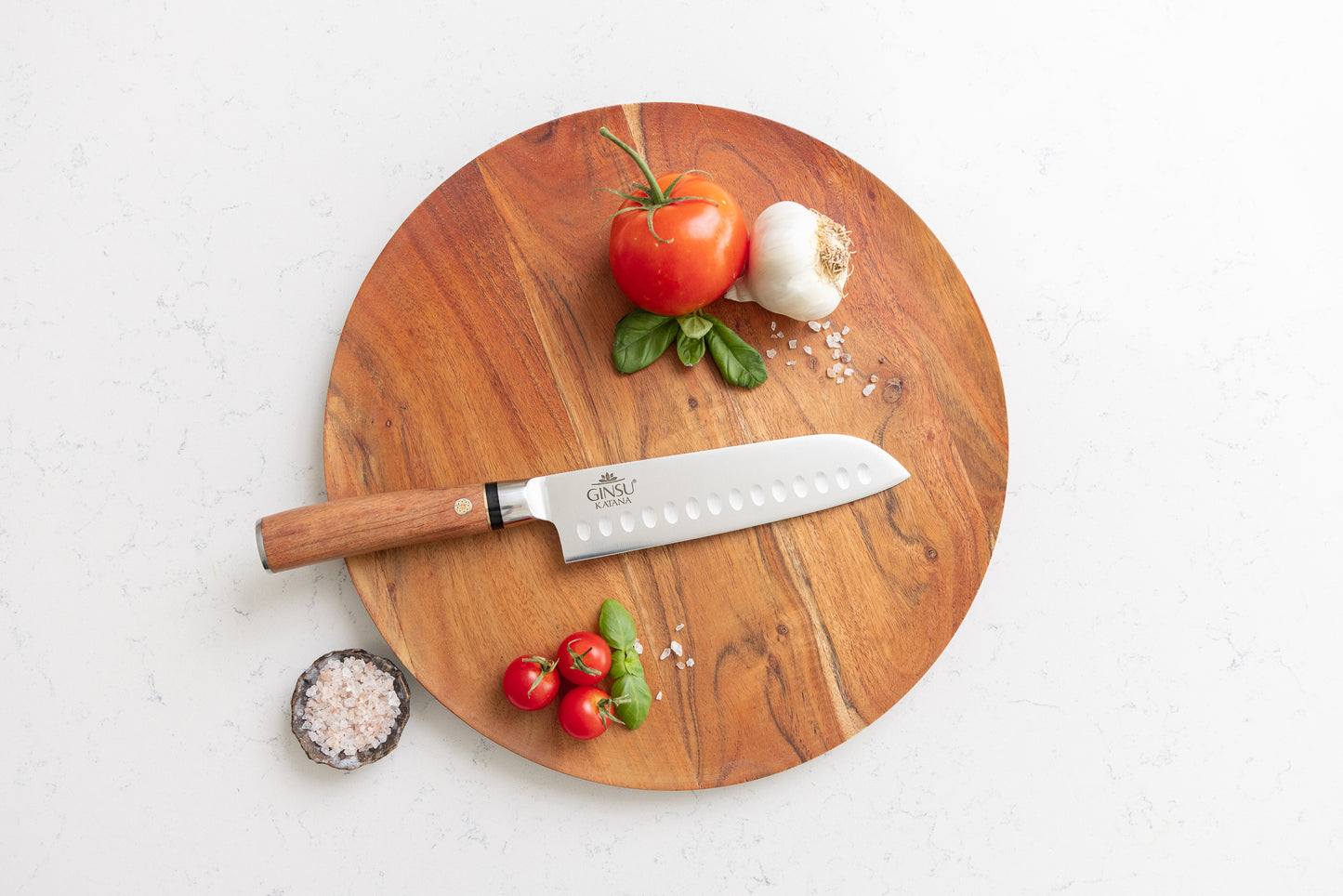
When it comes to equipping your kitchen with quality knives, the options can be overwhelming. Two popular choices that often leave home chefs pondering are the gyuto and santoku knives. Both originating from Japan, these versatile blades have distinctive features and purposes. Whether you're a professional chef or an aspiring home cook, selecting the right knife for your culinary needs is essential. In this blog post, we will explore the characteristics of the gyuto and santoku knives, highlighting their strengths and helping you make an informed decision about which one is best suited for your cooking style.
Gyuto
The gyuto knife, also known as the chef's knife, is a Western adaptation of the traditional Japanese knife. It has become a staple in both professional and home kitchens due to its versatility and all-purpose functionality. Here are the key features and advantages of the gyuto knife:

- Blade Design: The gyuto knife typically features a long, narrow blade with a gentle curve towards the tip. This design allows for a smooth rocking motion while cutting, making it ideal for tasks that require repetitive slicing or chopping. The curved blade profile enables efficient and precise cuts with minimal effort, reducing the strain on your hand and wrist.
- Length and Size: Gyuto knives come in various lengths, typically ranging from 8 to 10 inches. The longer blade offers ample cutting surface, allowing you to handle larger ingredients and make long, fluid cuts. This versatility makes the gyuto knife suitable for a wide range of tasks, from slicing through proteins and breaking down large cuts of meat to finely mincing herbs and vegetables.
- All-Purpose Performance: One of the main strengths of the gyuto knife lies in its ability to handle a multitude of kitchen tasks with ease. Whether you're dicing onions, mincing garlic, or slicing tomatoes, the gyuto knife performs exceptionally well. Its balanced design and versatile blade make it suitable for both delicate and heavy-duty cutting tasks, making it a go-to knife for professional chefs and home cooks alike.
- Tip Control: The pointed tip of the gyuto knife provides excellent control and precision. It allows you to perform intricate tasks such as removing seeds from peppers, trimming fat from meat, or creating decorative cuts. The fine point also aids in piercing and scoring techniques, enhancing your ability to tackle more complex recipes or presentation-focused dishes.
- Weight and Balance: The gyuto knife strikes a balance between weight and balance, offering stability during cutting while still being agile enough for controlled movements. The weight of the knife provides sufficient heft to handle tougher ingredients, allowing you to apply the necessary force without excessive exertion. Additionally, the well-balanced construction of the gyuto knife ensures a comfortable and controlled grip, reducing fatigue during prolonged use.
- Versatility: The gyuto knife's versatility extends beyond its performance in various cutting tasks. It can be used for different types of ingredients, from vegetables and fruits to boneless meats and fish. Its versatility eliminates the need for multiple knives, streamlining your kitchen tools and making it a practical choice for everyday cooking.
- Durability and Maintenance: Gyuto knives are typically crafted with high-quality materials, such as stainless steel or carbon steel. These materials ensure durability, longevity, and resistance to corrosion. However, proper care is still essential to maintain the knife's performance. Regular sharpening, honing, and hand washing are recommended to preserve the blade's sharpness and prevent any damage or rust.
The gyuto knife is an excellent choice for those seeking an all-purpose knife that can handle a wide variety of kitchen tasks. Its versatility and design make it a reliable workhorse for both professional chefs and home cooks. However, it may not be the best choice for those who prefer a lighter, more compact knife or have smaller hands. This is where the santoku knife comes into play.
SantokuThe santoku knife, originating from Japan, is a versatile and efficient blade that has gained popularity worldwide. The term "santoku" translates to "three virtues" or "three uses" in Japanese, referring to its versatility in handling various tasks in the kitchen. The Santoku is known for its unique characteristics and strengths that also make it a force in the kitchen. Let's explore the key characteristics and strengths of the santoku knife:

- Blade Design: The santoku knife features a wide, flat blade with a straight cutting edge. Unlike the curved blade of a gyuto knife, the santoku's flat profile allows for precise and controlled slicing, dicing, and chopping. The straight edge ensures clean cuts without the need for excessive rocking motions.
- Size and Length: The typical length of a santoku knife averages around 7 inches, making it shorter than a gyuto knife. This compact size offers excellent maneuverability and control, making it a preferred choice for individuals with smaller hands or those who prefer a lighter knife.
- Versatility: One of the major strengths of the santoku knife lies in its versatility. The wide blade provides a larger cutting surface area, allowing for efficient transfer of ingredients from the cutting board to the pan. It is well-suited for slicing, dicing, and chopping a variety of ingredients, including vegetables, fruits, and boneless proteins. The santoku knife's versatility makes it an excellent all-purpose knife for everyday cooking needs.
- Precise Cutting: The flat blade profile and sharp cutting edge of the santoku knife enable precise and clean cuts. This is particularly advantageous when working with ingredients that require accuracy, such as creating thin slices of vegetables or precise julienne cuts. The santoku knife's design allows for controlled movements, resulting in consistent and professional-looking cuts.
- Safety and Ease of Use: The santoku knife's compact size and balanced weight distribution make it easy to handle and control. It is an excellent choice for those who prefer a knife that feels light in hand, reducing the strain on the wrist and minimizing the risk of accidents. The balanced design ensures comfortable and controlled cutting motions, promoting a safer and more enjoyable cooking experience.
- Multipurpose Performance: While the santoku knife excels in slicing, dicing, and chopping tasks, it also performs well in other areas. Its flat blade profile and sharp edge make it suitable for delicate tasks such as mincing herbs or finely chopping garlic. The versatility of the santoku knife allows it to handle a variety of ingredients and cutting techniques, making it a reliable tool for a wide range of culinary applications.
- Low Maintenance: Santoku knives are often made with high-quality stainless steel, which offers durability and resistance to corrosion. This makes the knife relatively low maintenance, requiring less frequent sharpening and minimal effort in terms of cleaning and care.
The Santoku is an excellent knife in the kitchen to achieve many tasks. Its precise cutting capabilities, ease of use, and multipurpose performance make it a great choice for individuals seeking a reliable and efficient knife.
In conclusion, the decision of whether to buy a santoku or a gyuto knife depends on your personal preferences, cooking style, and specific needs in the kitchen. Both knives offer unique characteristics and strengths that can enhance your culinary experience.
If you value versatility, all-purpose performance, and a knife that can handle a wide range of tasks, the gyuto knife may be the right choice for you. Its curved blade profile, longer length, and weight balance make it suitable for slicing, dicing, and chopping various ingredients. The gyuto knife's versatility and adaptability make it a favorite among professional chefs and home cooks who value a single, go-to knife for most cooking tasks.
On the other hand, if you prefer precise and controlled cutting, a compact size, and a knife that excels in slicing and dicing, the santoku knife is worth considering. Its flat blade profile, straight cutting edge, and shorter length make it ideal for achieving clean and uniform cuts. The santoku knife's versatility, ease of use, and maneuverability make it a popular choice for those with smaller hands or who prefer a lighter knife.
Ultimately, the decision between a santoku and a gyuto knife comes down to your personal preferences and the specific tasks you perform in the kitchen. It may be helpful to try both knives or seek advice from professionals to determine which one feels more comfortable and suits your cooking style. Investing in a high-quality knife that aligns with your needs will undoubtedly enhance your culinary journey and make your time in the kitchen more enjoyable.
